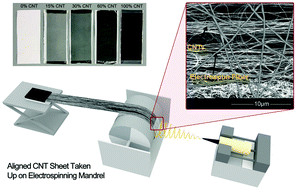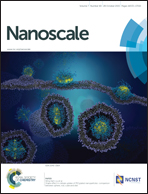High performance carbon nanotube – polymer nanofiber hybrid fabrics†
Abstract
Stable nanoscale hybrid fabrics containing both polymer nanofibers and separate and distinct carbon nanotubes (CNTs) are highly desirable but very challenging to produce. Here, we report the first instance of such a hybrid fabric, which can be easily tailored to contain 0–100% millimeter long CNTs. The novel CNT – polymer hybrid nonwoven fabrics were created by simultaneously electrospinning nanofibers onto aligned CNT sheets which were drawn and collected on a grounded, rotating mandrel. Due to the unique properties of the CNTs, the hybrids show very high tensile strength, very small pore size, high specific surface area and electrical conductivity. In order to further examine the hybrid fabric properties, they were consolidated under pressure, and also calendered at 70 °C. After calendering, the fabric's strength increased by an order of magnitude due to increased interactions and intermingling with the CNTs. The hybrids are highly efficient as aerosol filters; consolidated hybrid fabrics with a thickness of 20 microns and areal density of only 8 g m−2 exhibited ultra low particulate (ULPA) filter performance. The flexibility of this nanofabrication method allows for the use of many different polymer systems which provides the opportunity for engineering a wide range of nanoscale hybrid materials with desired functionalities.


 Please wait while we load your content...
Please wait while we load your content...